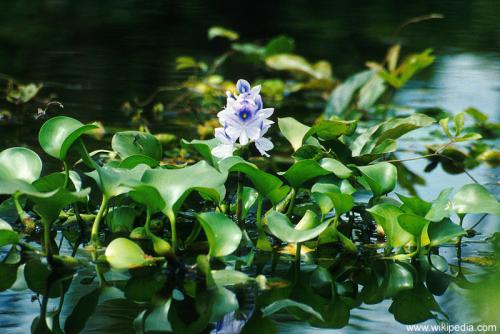Weeds of Worth?
Constructed in 1537 by King Kempe Gowda, Hebbal Lake has seen a multitude of uses since then: as a reservoir for drinking water, a source of livelihood for local fisher-folk, a haven for many species of birds, even a welcome sight for the sore eyes of the NCBS shuttle commuter, with its expanse of water, pelicans and painted storks.
Sadly, however, other uses have also been found. Drains from neighboring localities flow into the lake. Sewage almost always acts as a fertiliser for a water body due to an influx of nutrients; and Hebbal Lake has been no exception. One of the many consequences: a lush green mat of water hyacinth cloaking the surface of the lake.
The common water hyacinth Eichhornia crassipes, native to parts of South America, was introduced into water bodies across the world - including India - for its delightful purple blooms. But beauty aside, most biologists see these perennial aquatic plants as chokers of the water ecosystems they invade, having the ability to almost double in number fortnightly under ideal conditions. Apart from causing a drop in dissolved oxygen levels, leading to fewer fish and native water flora, studies have also proved that the invasion of water hyacinth significantly alters community composition. The rich growth of hyacinth also offers a perfect micro-habitat for many vectors of disease. Furthermore, the spread of hyacinth over water bodies leads to the clogging of hydropower and water-supply systems and it deters activities such as fishing, causing economic loss.
No wonder then that methods to suppress the spread of the hyacinth are in vogue across the world: be it the liberal use of chemical herbicides, introduction of exotic control agents or the manual removal of the free-floating plants. In Hebbal Lake, for instance, two species of exotic weevils, Neochetina eichhorniae and N. bruchi (both known to control water hyacinth growth in its native South America) were introduced in October 1983. The hyacinths of Hebbal seem to be doing no worse today.
And a question lingers: Is the water hyacinth truly a bane? Or could we be overreacting to the issue?
Some studies show an increase in native insect diversity in hyacinth-infected water bodies, for the same reason that they act as a breeding ground for diseases - water hyacinths bring in more strata to a water body. Increases in insect diversity in turn bring in more predators be it birds, reptiles or amphibians. Ecologically, the plants also play another important role: that of a biological filter. The water hyacinth can tolerate very high levels of heavy metals like arsenic, mercury, chromium, nickel and toxins such as cyanide. The plants absorb most of these poisons and help purify water, a process called phytoremediation. Water hyacinths are used around the world in waste-water treatment regimes.
Water hyacinths have other uses too. In the Philippines, for instance, hyacinths are harvested for a purpose - fibre extracted from these plants can make excellent rope. Baskets, mats, handicrafts, even furniture including sofas can be crafted out of hyacinth rope and fibre. Hyacinth pulp can also be used to make paper. In most parts of India, however, water hyacinths are manually removed from the water surface and then ignored: mostly flung on the banks of the water body and left to rot. The next time you travel past Hebbal Lake, look closely at its banks and you can see this happening.
Studies have shown that the water hyacinth is a good source of biofuel - both bioethanol and biogas - and yield from hyacinth leaves is comparable to that obtained from other agricultural wastes. Mixed with ash and animal manure, hyacinths can be used as fertilizer too. Indian scientists have found that hyacinth biomass composts faster than regular agricultural waste. Hyacinth compost also increases the rate at which earthworms multiply, which further improves the process of composting.
Animal fodder, fish feed, charcoal briquettes, fibreboards - the list of derivatives from the water hyacinth is really quite long. Dried plants can even be used as an alternative to fuelwood.
What about the future? The common water hyacinth is now widespread across the country and has almost become part of the landscape. Is biological or chemical control which can cause further damage to the environment worth the trouble? Manual removal though costly, may prove to be a viable alternative, given the amazing array of potential uses the harvested plants can be put to. Numerous small-scale industries could be easily set up, which would make it possible to generate jobs and at the same time help contain the extensive spread of this fast-growing perennial.
Around the world some conservationists are looking at invasive species like the water hyacinth with a more open mind. Perhaps we should not always rush to judgement?


Comments
Post new comment